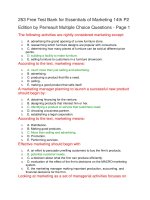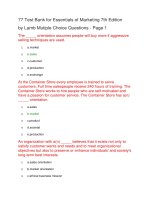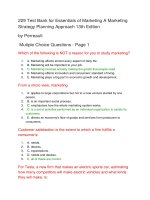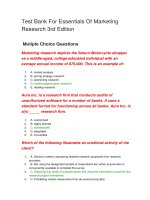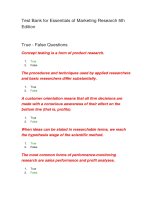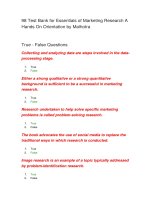234 test bank for essentials of marketing 3rd edition đề trắc nghiệm marketing
Bạn đang xem bản rút gọn của tài liệu. Xem và tải ngay bản đầy đủ của tài liệu tại đây (245.08 KB, 56 trang )
234 Test Bank for Essentials of Marketing 3rd Edition
Mutiple Choice Questions - Page 1
Satisfaction is
1.
2.
3.
4.
a.a match between consumer expectations and good or service performance
b.an evaluation of service quality compared to price
c.a global measure of service quality performance
d.based on the level of service quality as compared to competitive offerings
Marketing is described by management guru Peter Drucker
as
1.
2.
a.enhancing consumers’ well-being and quality of life
b.the most effective engine of economic development, particular in its ability to
develop entrepreneurs and managers
3. c.the process of planning and executing the conception, pricing, promotion, and
distribution of goods and services
4. d.the exchange process whereby goods and services are exchanged for money
The marketing concept consists of all of the following
components except
1.
2.
3.
4.
a.an integrated marketing approach
b.a value-based philosophy
c.an organizational goal orientation
d.a concern for societal needs
Successful marketers must be able to identify target
consumers as well as their
1.
2.
3.
4.
a.needs
b.wants
c.demands
d.all of the above
The selling concept has as its primary goal increasing sales
volume, whereas the _____ philosophy has as its
primary goal addressing customer needs and
wants.
1.
2.
3.
4.
a.production
b.product
c.marketing
d.societal marketing
_____ are shaped by an individual’s culture.
1.
2.
3.
4.
a.Needs
b.Wants
c.Demands
d.Values
Basic human requirements such as food, water, clothing,
and shelter would be classified as a
1.
2.
3.
4.
a.want
b.demand
c.need
d.market
When the patent on a new drug expires, competing firms will
often develop alternative medicines that offer
consumers the same drug at a cheaper price. This
philosophy of marketing is based on the
1.
2.
3.
4.
a.production concept
b.product concept
c.selling concept
d.marketing concept
Going on a safari in Kenya or riding an elephant at the zoo
would be examples of
1.
2.
3.
4.
a.goods
b.services
c.products
d.ideas and experiences
The central concept behind marketing is
1.
2.
3.
4.
a.meeting consumers’ needs and wants
b.satisfying the demand of consumers
c.the exchange process
d.understanding consumers’ needs, wants, and demands
Intangible activities or benefits that individuals acquire, but
that do not result in ownership are called
1.
2.
3.
4.
a.goods
b.ideas and experiences
c.services
d.products
Marketing has evolved over time and therefore, a firm can
take different approaches to marketing. All of the
following are possible approaches except
1.
a.placing a heavy emphasis on producing the best product it can, hoping someone
will buy it
2. b.reducing costs through improved manufacturing processes and technological
development, thus selling its products at a lower price
3. c.placing a heavy emphasis on the distribution channel, offering customers optimal
access to the product
4. d.placing a heavy emphasis on selling its products to consumers and businesses,
striving to convince customers of the superiority of its products
In the 4 P’s of marketing, place refers to the
1.
2.
3.
4.
a.distribution process
b.research process
c.exchange process
d.integrated process of combining price and promotion
_____ is defined as the overall good or service quality,
reliability, and the extent to which it meets consumers’
needs.
1.
2.
3.
4.
a.Value
b.Demand
c.Quality
d.Satisfaction
The _____ concept assumes that consumers prefer products
that are of the highest quality and optimal
performance.
1.
2.
3.
4.
a.production
b.product
c.selling
d.marketing
The 4 P’s of marketing are
1.
2.
3.
4.
a.price, promotion, product, and perceived quality
b.price, perception, product, place
c.price, product, people, promotion
d.price, product, promotion, and place
The _____ concept assumes that consumers prefer products
that are easily accessible and inexpensive.
1.
2.
3.
4.
a.production
b.product
c.selling
d.marketing
A need becomes a want when
1.
2.
3.
4.
a.it is directed at a particular need
b.it is directed at a particular product
c.it meets physiological needs such as hunger and thirst
d.it is backed by the ability to make a purchase
Value is
1.
2.
3.
4.
a.the overall quality of a product
b.based on the level of satisfaction with a product
c.the overall price given the quality of a product
d.based on price, quality, and satisfaction
The sum of all goods and services produced within the
boundaries of a country is the
1.
2.
3.
4.
a.national product index (NPI).
b.gross domestic product (GDP).
c.gross national product (GNP).
d.marketing orientation.
More than 30 million Americans work entirely or in part in
assisting the marketing system, with _____ accounting
for the largest segment.
1.
2.
3.
4.
a.salespeople
b.advertising
c.brand managers
d.business-to-business buyers
The process of developing and nurturing relationships with
the parties participating in the transactions involving a
company’s products is called
1.
2.
3.
4.
a.relationship marketing
b.marketing
c.promotion
d.the marketing concept
_____ is/are defined as all of the actual and potential
consumers of a company’s products.
1.
2.
3.
4.
a.Markets
b.Marketing
c.Needs
d.Wants
When a pharmaceutical company such as Pfizer works to
develop a new drug for cancer or other major illness, it
is using the
1.
2.
3.
4.
a.production concept
b.product concept
c.marketing concept
d.societal marketing concept
All of the following are examples of services except
a
1.
2.
3.
4.
a.facial at a beauty salon
b.trip to the beach
c.a dental check-up
d.taxi ride to a sporting event
Goods refer to
1.
2.
3.
4.
a.tangible products such as clothing
b.intangible products such as a hair cut
c.concepts and experiences such as a trip to the ocean
d.products that are sold through retail outlets
The _____ concept assumes that a company can compete
more effectively if it first researches consumers’
generic needs, wants, preferences, as well as product
or service-related attitudes, and personal
interests.
1.
2.
3.
4.
a.production
b.product
c.selling
d.marketing
The key to whether consumers or businesses will purchase a
product again is the
1.
2.
3.
4.
a.price
b.price relative to quality
c.overall value
d.overall level of satisfaction
The _____ concept assumes that consumers left alone will
normally not purchase the products the firm is selling,
or not purchase enough products.
1.
2.
3.
4.
a.production
b.product
c.selling
d.marketing
When a Burger King offers $1.00 off coupons for their
Whopper sandwich in an insert in the Sunday
newspaper, Burger King is using the
1.
2.
3.
4.
a.product concept
b.production concept
c.selling concept
d.marketing concept
With the _____, the focus is on persuading consumers to
make a purchase rather than offering them the
products that best fit their needs and interests.
1.
2.
3.
4.
a.production concept
b.selling concept
c.marketing concept
d.societal marketing concept
101 Free Test Bank for Essentials of Marketing 3rd
Edition by Lascu Mutiple Choice Questions - Page
2
Data mining involves computer analysis of
1.
a.channel data to determine what products are selling at which stores
2.
b.customer data to determine patterns, profiles, or relationships for the purpose of
profiling or predicting purchase behavior
3. c.customer data to determine the best direct marketing methods
4. d.customer data to determine consumer needs, wants, and desires in order to
successfully create marketing communications directed to each customer
An example of a _____ is the purchase of a bicycle by a
college student for transportation to and from
class.
1.
2.
3.
4.
a.need
b.want
c.desire
d.demand
Satisfying basic human requirements is satisfying
_____.
1.
2.
3.
4.
a.needs
b.wants
c.desires
d.demands
The selling concept that emerged in the 1930s was the result
of
1.
2.
3.
4.
a.the lower prices that emerged from following the product concept
b.understanding consumers’ needs and wants
c.excess supply caused by overproduction
d.understanding the relationship between supply and demand
The overall price given the quality of the product; perceived
as important in the purchase decision, is the definition
of
1.
2.
3.
4.
a.quality
b.demand
c.value
d.satisfaction
In the process of adopting the societal marketing concept,
many companies will
1.
2.
a.partner with nonprofit firms to engage in cause-related marketing
b.utilize the production concept to reduce costs and thereby allow more members
of society to purchase its products
3. c.utilize only domestic suppliers to reduce the dependence on the world economy
4. d.focus on providing post-purchase service to the buyer
At the heart of marketing is
1.
2.
3.
4.
a.planing and executing price, promotion, and distribution
b.value, quality and satisfaction
c.exchange
d.satisfying consumer’s needs
A want becomes a demand when
1.
2.
3.
4.
a.it is backed by the ability to buy the respective good or service
b.it is directed toward a particular product
c.it meets a physiological, safety, social, self-esteem, or self-actualization need
d.it is shaped by one’s culture
Quality is defined as the
1.
2.
a.overall level of performance relative to price
b.overall product quality, reliability, and extent to which the product meets the
consumer’s needs
3. c.performance of a product relative to consumer expectations of an ideal service
4. d.match between consumer expectations and consumer satisfaction
Successful companies that adopt a value-base philosophy
are also likely to
1.
2.
3.
4.
a.use green marketing
b.use a selling concept
c.invest in society, primarily for altruistic reasons, that benefit society
d.use a product orientation
In the 1950s, the marketing philosophy(s) that emerged
was/were the
1.
2.
3.
4.
a.product/production concepts
b.selling concept
c.marketing concept
d.societal marketing concept
The marketing philosophy(ies) that were predominant in the
United States between 1870 and 1930 was/were
the
1.
2.
3.
4.
a.product/production concepts
b.selling concept
c.marketing concept
d.societal marketing concept
During the selling era, which was from 1930 to 1950,
1.
a.retailers and wholesalers were only of peripheral concern since products
practically sold themselves
2. b.firms attempted to fit products within their production capabilities rather than on
customer needs
3. c.firms focused on the physical production and the production process
4. d.supply exceeded demand
According to the American Marketing Association, marketing
is defined as an organization function and a set of
processes for creating, communicating, and
delivering
1.
a.goods and services to consumers and businesses to meet needs, wants, and
desires
2. b.communication messages to consumers and businesses to inform and persuade
individuals and businesses to make purchases
3. c.value to customers and for managing customer relationships in ways that benefit
the organization and its stakeholders
4. d.value to consumers and businesses through the delivery of goods and services
to meet individual and corporate needs
An example of a _____ is a discerning adult that has the
financial resources to purchase an expensive sports
car or yacht.
1.
2.
3.
4.
a.need
b.want
c.demand
d.market
The marketing concept(s) which are most likely to lead to
marketing myopia is(are) the
1.
2.
3.
4.
a.marketing concept
b.societal marketing concept
c.selling, product, and production concepts
d.product and production concepts
If expectations of a good or service are greater than
performance, consumers are likely to be
1.
2.
a.satisfied and will likely purchase the good or service again
b.somewhat satisfied, but would switch to another good or service without much
persuasion
3. c.dissatisfied and will likely engage in negative word-of-mouth communications
and firm switching behavior
A match between consumer expectations and good or
service performance, is the definition of
1.
2.
3.
4.
a.quality
b.demand
c.value
d.satisfaction
The _____ concept assumes that the company will have an
advantage over competitors if it applies the marketing
concept in a manner that maximizes society’s well
being.
1.
2.
3.
4.
a.production
b.selling
c.marketing
d.societal marketing
Through data mining, retailers hope to do all of the following
except
1.
a.increase sales from a company’s existing customers, and hence solidify and
increase market share
2. b.determine purchase habits of consumers with regard to price preferences, sale
or regular prices, fashion, and size
3. c.obtain information about products, services, and marketing practices of the
competition
4. d.determine the best direct marketing techniques to use with each individual
customer
Key elements of the societal marketing concept are all of the
following except
1.
2.
3.
4.
a.data mining
b.an integrated marketing approach
c.a focus on consumer needs and the needs of society
d.a value-based philosophy
Markets are defined as
1.
2.
3.
4.
a.basic human requirements such as food and water
b.wants based by the ability to buy the good or service brand
c.the execution of the production, pricing, promotion, and distribution of a product
d.all of the actual and potential consumers of a company’s products
Customer relationship management does all of the following
except
1.
2.
a.use technology for mining data related to customer preferences and behaviors
b.boost customer satisfaction by providing consistent, seamless, quality
experiences
3. c.enhance efficiency and effectiveness of customer contacts
4. d.provide the ultimate organizational goal for an organization
A company-wide culture that creates the necessary
behaviors for delivering superior values to buyers is
called
1.
2.
3.
4.
a.the societal marketing concept
b.an integrated marketing approach
c.a market orientation
d.marketing myopia
The gross domestic product is the sum of all goods
1.
2.
3.
4.
a.produced within the boundaries of a country
b.and services produced within the boundaries of a country
c.and services produced by a country regardless of where it is produced
d.produced by a country regardless of where it is produced
The tendency of marketing efforts to focus on products,
production, or sales and ignore specific consumer
needs or important markets is called
1.
2.
3.
4.
a.marketing myopia
b.the marketing concept
c.societal marketing concept
d.relationship marketing
The marketing concept(s) that predominated in the United
States between 1930 and 1950 was/were the
1.
2.
3.
4.
a.product/production concepts
b.selling concept
c.marketing concept
d.societal marketing concept
Customer relationship management is the
1.
2.
a.holistic process of identifying, attracting, differentiating, and retaining customers
b.estimated profitability of a customer over his or her entire relationship with the
company
3. c.estimated profitability of a customer over his or her lifetime
4. d.holistic multichannel approach to marketing to customers when and where they
want to make purchases
The ultimate organizational goal is to create profit for the
company
1.
2.
3.
4.
a.and wealth for its shareholders
b.and jobs for its employees
c.and meet the needs of society in which it operates
d.while meeting the needs of society
The process of reducing demand for your own product when
it is in the best interest of society is called
1.
2.
3.
4.
a.societal marketing
b.demarketing
c.marketing
d.cause-related marketing
The danger of the product, production, and selling concepts
is
1.
2.
3.
4.
a.that they ignore the concept of supply and demand
b.that they may lead to marketing myopia
c.the excess supply caused by overproduction
d.the lack of product variety
101 Free Test Bank for Essentials of Marketing 3rd
Edition by Lascu Mutiple Choice Questions - Page
3
Communication in the form of advertising, personal selling,
sales promotions, and public relations is the _____
component of the 4 P’s.
1.
2.
3.
4.
a.promotion
b.price
c.product
d.place
Distribution of a company’s goods and services is the _____
component of the 4 P’s.
1.
2.
3.
4.
a.promotion
b.price
c.product
d.place
Through data mining, retailers hope to do all of the following
except
1.
a.increase sales from a company’s existing customers, and hence solidify and
increase market share
2. b.determine purchase habits of consumers with regard to price preferences, sale
or regular prices, fashion, and size
3. c.which manufacturers offer the highest margin products
4. d.find out who customers are, what they buy, and how often
All of the following statements are true about the production
era (from 1870 to 1930), except the fact that
1.
a.firms attempted to fit products within their production capabilities rather than on
customer needs
2. b.retailers and wholesalers were only of peripheral concern since products
practically sold themselves
3. c.supply exceeded demand
4. d.firms focused on the physical production and the production process
Marketing has evolved over time and therefore, a firm can
take different approaches to marketing. All of the
following are possible approaches except
1.
a.placing a heavy emphasis on producing the best product it can, hoping someone
will buy it
2. b.finding out how customers can be reached, then develop promotional materials
that will be the most effective at reaching customers
3. c.finding out what customers want first, then develop products to meet those
wants
4. d.finding out what customers want, then produce products in such a way that will
benefit society as well as the customer
Key elements of the societal marketing concept includes all
of the following, except
1.
2.
3.
4.
a.an organizational goal orientation
b.integration through customer relationship management (CRM)
c.a focus on international markets
d.an integrated marketing approach
When Wal-Mart searches for ways to reduce distribution
costs so they can reduce the price of products they
sell to consumers, Wal-Mart is using the
1.
2.
3.
4.
a.production concept
b.product concept
c.selling concept
d.marketing concept
The American Consumer Satisfaction Index is a national
economic indicator of the quality of
1.
a.goods and services from national and international companies within the United
States
2. b.services from companies producing about one-third of the GDP
3. c.goods from companies producing about one-third of the GDP
4. d.goods and services from companies producing about one-third of the GDP
The main disadvantage of the product and the production
orientation is that the focus is the product and
production process rather than
1.
2.
3.
4.
a.the distribution channels
b.the 4 P’s of marketing
c.the consumer
d.the selling process
The sales era was the period between _____ when the
primary focus of marketing was on selling.
1.
2.
3.
4.
a.1870 and 1930
b.1930 and 1950
c.1950 and 1980
d.1950 until the present
Customer lifetime value is the estimated
1.
a.income of a customer over the course of his or her entire relationship with a
company
2. b.income of a customer over the course of his or her entire lifetime
3. c.profitability of a customer over the course of his or her entire relationship with a
company
4. d.profitability of a customer over the course of his or her entire lifetime
Customer relationship management does all of the following
except
1.
a.incorporate an organizational focus on the behavior of and communication with
the customer
2. b.use technology for mining data related to customer preferences and behaviors
3. c.develop direct marketing approaches to maximize customer lifetime value
4. d.share collected data across the entire company
The production era was the period between _____ when the
primary focus of marketing was on producing the best
products possible at the lowest possible price.
1.
2.
3.
4.
a.1870 and 1930
b.1930 and 1950
c.1950 and 1980
d.1950 until the present
The production concept assumes that
1.
2.
3.
a.consumers prefer products that are easily accessible and inexpensive
b.consumers, if left alone, will normally not purchase products a firm is selling
c.consumers prefer products that are of the highest quality and optimal
performance
4. d.a company can compete more effectively if it first researches the needs, wants,
and preferences of consumers
When a telemarketer tries to convince you to sign up for a
particular credit card, he or she is using the
1.
2.
3.
4.
a.production concept
b.product concept
c.selling concept
d.marketing concept
When a retail store has a big back-to-school sale in August,
the store is using the
1.
2.
3.
4.
a.production concept
b.product concept
c.selling concept
d.marketing concept
The main disadvantage of the selling orientation is that the
focus is on persuading consumers to make a purchase
rather than
1.
2.
3.
4.
a.offering the products that best fit the consumer’s needs and wants
b.focusing on reducing costs of production and lower prices for consumers
c.focusing on high quality products
d.where the product can be sold
Convenient locations, attractive products, appropriate
pricing, and well-targeted promotions are indicative of
a firm using the
1.
2.
3.
4.
a.marketing concept
b.product concept
c.production concept
d.selling concept
If performance of a good or service matches expectations,
consumers are likely to be
1.
2.
a.satisfied and will likely purchase the good or service again
b.somewhat satisfied, but would switch to another good or service without much
persuasion
3. c.dissatisfied and will likely engage in negative word-of-mouth communications
and firm switching behavior
The marketing concept assumes that
1.
a.a company will have an advantage over competitors if it applies the marketing
concept in a manner that maximizes society’s well-being
2. b.consumers, if left alone, will normally not purchase products a firm is selling
3. c.consumers prefer products that are of the highest quality and optimal
performance
4. d.a company can compete more effectively if it first researches the needs, wants,
and preferences of consumers
Tangible products, such as a television or stereo, are
called
1.
2.
3.
4.
a.goods
b.ideas and experiences
c.services
d.products
For optimal performance in the marketplace, firms must
adopt a marketing strategy using the 4 P’s to address
consumer needs. This requires that a company does
all of the following except
1.
2.
a.offer goods and services that best satisfy consumer needs
b.offer a price the consumer perceives is fair in return for the value received
3.
c.make the product available at retailers that are conveniently located close to the
consumer
4. d.use cause-related marketing efforts that are endorsed by the consumer
The marketing era was the period from _____ when the
primary focus of marketing shifted to the needs and
wants of consumers and society.
1.
2.
3.
4.
a.1870 to 1930
b.1930 to 1950
c.1950 to 1980
d.1950 until the present
Services refer to
1.
2.
3.
4.
a.tangible products such as clothing
b.intangible products such as a hair cut
c.concepts and experiences such as a trip to the ocean
d.products that are sold through retail outlets
When Arby’s produces sandwiches that are preferred by
their target audience, they are using the
1.
2.
3.
4.
a.selling concept
b.product concept
c.societal marketing concept
d.marketing concept
When Intel develops a newer, better computer chip because
they believe consumers want faster computers, it is
using the
1.
2.
3.
4.
a.production concept
b.product concept
c.selling concept
d.marketing concept
When Arby’s becomes involved in supporting the Boys &
Girls Club of America as part of their marketing
strategy, it is using the
1.
2.
3.
4.
a.selling concept
b.product concept
c.societal marketing concept
d.marketing concept
All of the following are examples of goods except
1.
2.
3.
4.
a.computer
b.computer software
c.computer repair
d.computer monitor
Marketing myopia is the tendency to focus on
1.
a.products, production, or sales and ignore specific consumer needs or important
markets
2. b.individual consumer needs and ignore societal needs
3. c.consumer needs and wants and ignore business needs and wants
4. d.local or domestic markets and ignore international needs
Relationship marketing is the process of developing and
nurturing relationships with
1.
2.
3.
4.
a.a firm’s end-users or customers
b.a firm’s target market
c.a firm’s suppliers, vendors, and contractors
d.all the parties participating in the transactions involving a company’s products
The product concept assumes that
1.
2.
3.
a.consumers prefer products that are easily accessible and inexpensive
b.consumers, if left alone, will normally not purchase products a firm is selling
c.consumers prefer products that are of the highest quality and optimal
performance
4. d.a company can compete more effectively if it first researches the needs, wants,
and preferences of consumers
Perceived _____ has the greatest impact on
satisfaction.
1.
2.
3.
4.
a.value
b.demand
c.service
d.quality
The holistic process of identifying, attracting, differentiating,
and retaining customers is
1.
2.
3.
4.
a.customer lifetime value
b.customer relationship management
c.multichannel marketing
d.value-based philosophy
The societal marketing concept assumes that
1.
a.a company will have an advantage over competitors if it applies the marketing
concept in a manner that maximizes society’s well-being
2. b.consumers, if left alone, will normally not purchase products a firm is selling
3. c.consumers prefer products that are of the highest quality and optimal
performance
4. d.a company can compete more effectively if it first researches the needs, wants,
and preferences of consumers


